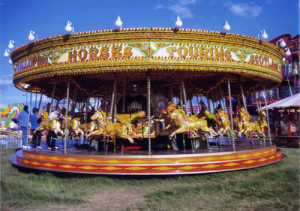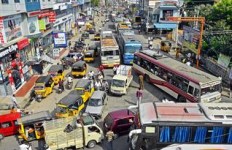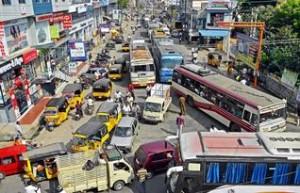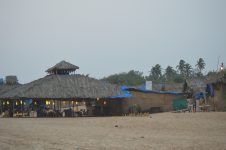
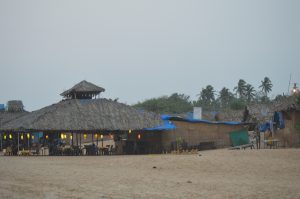
This blog is based on our recent trip to India. Every time I go to India I find myself lost due to the changes that have happened in a short period of time. The shops, roads, traffic, the system everything is changed. So I thought this time it will be great to write a blog on that experience.
Airports – In India only people with a valid ticket are allowed inside the airport. I am not sure if this is the case in other countries but certainly I haven’t had that experience in my travels. In airports like London Heathrow anybody can go into the departures, so you have the luxury of saying good bye to your friends or family inside the airport. I am writing about this because I had checked in online and I had chosen the option of getting the boarding pass at the check in desk. So I am on my way to the airport and I realise that I don’t have a copy of the e ticket and won’t be able to go inside the airport without a ticket. Luckily they do allow you to show your e ticket on your mobile phone, so I was allowed inside. So folks if you are going to fly in India make sure you have a ticket or a boarding pass to actually get into the airport.
Disabled access – India is developing rapidly but definitely the disabled and the elderly have been forgotten in terms of infrastructure. We took a push chair for our 7 month old baby so that he can play or sleep when he wants to. Unfortunately we gave up using it because India is not designed for disabled people. This blog on NDTV really gives you an insight of a disabled man’s suffering in India https://www.ndtv.com/blog/my-wheel-chair-and-i-excluded-by-india-740208 I don’t need to say more.
Uber/auto – Wow, Uber is brilliant, book your taxi via an app, get in the taxi, enjoy the drive, your friend or family can track your location throughout the time, send alarm signals if something is suspicious, pay what the app tells you and rate the driver at the end of your journey on the app. What a brilliant idea. No bargaining/argument with an auto driver, no rigged auto meters and the rest which comes with it.
Food/hygiene – If you like food and especially Indian food, the place to be is India. It was an absolute treat for somebody who has been eating so called Indian food in the UK cooked by Bangladeshi chefs adapted for the English palate. Talking about food hygiene in India – certainly there is progress but you still see in a lot of places even wearing a simple plastic gloves would make a great difference but people don’t use it. Obviously we don’t know what happens in the kitchen or how clean the kitchen is. Unfortunately there are no health inspectors or food inspectors in India who can check the cleanliness and hygiene of these places. Even if there are any I guess they turn a blind eye as long as they are bribed well.
Goa – We went to Goa on a short trip. We went in an off season, so it was very hot but the food, beaches etc were all amazing. The resort which we stayed was excellent. Customer service is incredible in India, we had a little baby who was having mashed up food, they prepared it for us as we asked and even did room service. Thank you.
Garbage/plastic bags – Plastic bags are banned in Bengaluru but it’s still widely used and is available. The reason for this is 1 word – corruption. Corrupted and ignorant minds of shop keepers/consumers and the same applies for the government staff who are supposed to enforce it.
Muslim vendors/shopping – Shopping in India is a skilled job. You need to be local and know the prices if not you get ripped off. Bargaining is a mandatory and useful skill. When we went shopping although we look Indian we didn’t speak the local language, so people immediately recognised us as outsiders and the prices went up high. Interestingly when we went shopping during the holy month of Ramadan started we saw that the prices were reasonable. During the month of Ramadan adhere to certain principles and 1 amongst them is honesty and no cheating. So if you want to get decent bargain and not get ripped off, shop in the holy month of Ramadan if they are a Muslim vendor. I don’t know if Hindus have this culture during their holy festivals.
Traffic and roads– Bengaluru has a huge traffic problem and the government doesn’t have a long term plan about it. Bengaluru is known for it’s small roads and now a surge in the population due to the IT industry means the city is not coping. The government’s argument is that it is taking steps to tackle the traffic problem but on the ground reality they find that no change and in fact they feel it’s getting worse.
Cost of Living – Every time I go to India, which is once in every 2 years (this time it was 4 years gap), I am shocked to see the rise in the cost of living. We always go to a major city, so can’t comment much about smaller towns and villages. We went out to a pub in a mall in Bangalore. 3 of us had 2 rounds of whisky and some chicken alongside it. The total bill was 11000 Rs. I was absolutely gobsmacked to see the price, interestingly we can buy 3 full bottles of the same whisky for that price. My friends who were with me found it to be normal. It’s not just the pubs, it’s the same with everything else. A family eating out at a restaurant can easily cost you Rs 2000 which is still a lot of money for the wages people earn.
Skilled Labour work – India has always been good in recycling and a willingness to repair old stuff. The Europeans and the Americans way is to just chuck them out or replace the whole thing. I have a touch screen Lenovo laptop which had problems starting up. When we managed to start it, it worked a treat. So restarting it was a major problem because it may take hours or may not start at all. So I took it to 1 of the premier shops in the UK which sells computers and repairs them. The answer was to get a new whole motherboard and I was quoted a total cost of 350£ for which you can actually buy a new laptop. I did not go ahead and wanted to try my luck in India. It was fixed for 2500Rs, they needed to change a chipset and since then it has been working fine.
Economic divide – Indian economy has seen tremendous progress in the last 2 decades. But the progress has not been reflected in terms of economic equality. The division between the rich and the poor has got wider. I think only when we achieve a certain standard of economic equality is reduced India will be considered a developed country.
Healthcare – eye operation, mum scans – Healthcare in India is predominantly private sector. I have 2 interesting tales to share. My mum had some neurological symptoms for which we took her to a Neurologist. I myself suspected a condition and the neurologist thought the same. The diagnosis is usually made with a clinical examination and no tests can identify this problem. I am pretty sure that the neurologist was very aware of that but inspite of that he ordered us to take scans which were irrelevant. The interesting part was when he suggested lung function tests for a problem which was arising from the brain. Unfortunately there are no systems in place to challenge a decision like that and there are no guidelines for medical professionals regarding this at a medical council level as well, so all doctors get away with this. The 2nd story is a really positive story, my wife wanted to correct her vision through Laser eye surgery. So we rang 3 hospitals in the same city for quotes, 3 different quotes ranging from 250000 Rs to 100000 Rs. We went with the cheapest option and the care was excellent. It’s an interesting scenario because the procedure, the technology and the skill set are all the same but there is a huge difference in the cost. It’s a shame the way Indian health care system is as we have some of the best healthcare professionals in the world living in India and living abroad.
Overall we can see good and bad changes but progress is still being made. I hope for the best.






